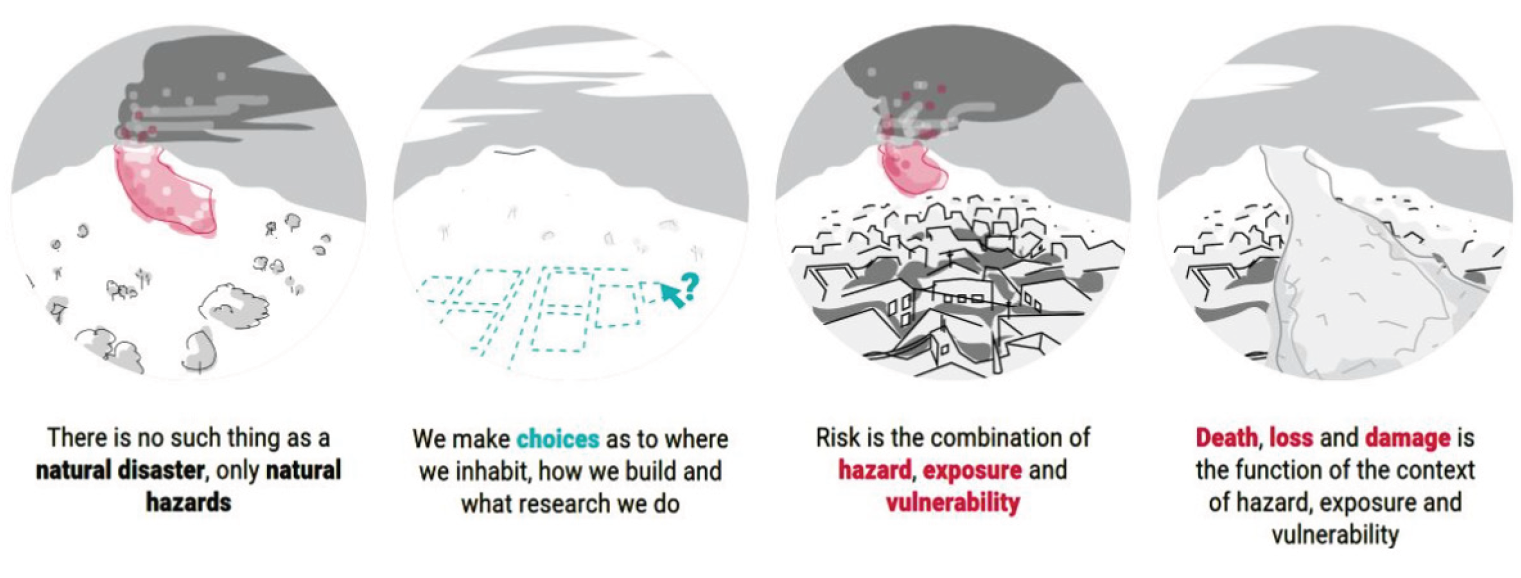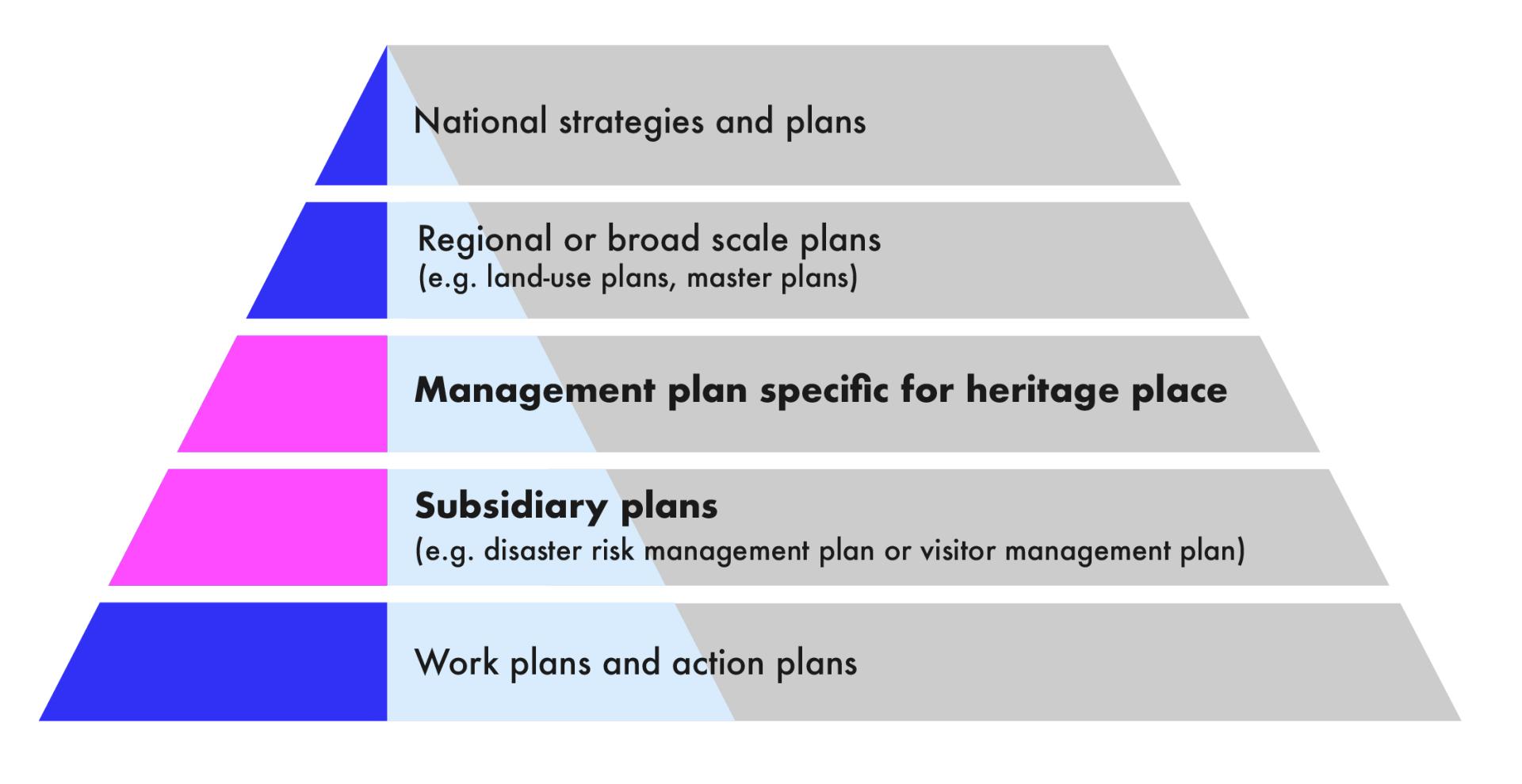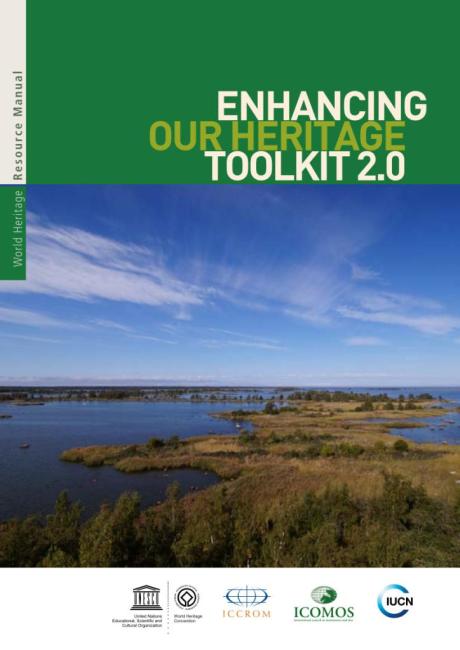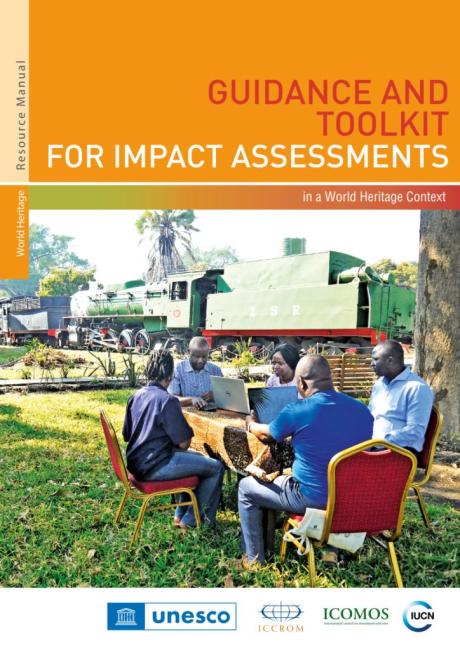Disaster risk management
- Analysing risks in terms of how certain natural and/or human-induced hazards interact with different types of heritage places, their values and the attributes that carry those values, is critical.
- DRM provides general principles and a methodology that enables managers in reducing disaster risks and mitigating potential impacts to attributes of their heritage places.
- Disaster risk can be identified by taking account of hazards, potential impacts to attributes and people, levels of exposure of the heritage place and communities to specific hazards and vulnerabilities.
- Effective DRM needs continuous and iterative processes of planning, coordinating, implementing, monitoring and progressive improvement.
- Managers need to identify hazards, vulnerabilities and levels of exposure of their heritage place, so that they can prepare a disaster risk assessment and plan appropriate management actions for each of the three phases of the DRM cycle: pre-disaster (prevention/mitigation/preparedness), during disaster (emergency/response), and post-disaster (recovery).
- DRM objectives should be aligned with the
World Heritage property
A cultural, natural or mixed heritage place inscribed on the World Heritage List and therefore considered to be of OUV for humanity. The responsibility for nominating a property to the World Heritage List falls upon the State(s) Party(ies) where it is located. The World Heritage Committee decides whether a property should be inscribed on the World Heritage List, taking into account the technical recommendations of the Advisory Bodies following rigorous evaluation processes.
When used as a general term, World Heritage refers to all the natural, cultural and mixed properties inscribed on the World Heritage List. ’s overall management objectives and consistent with the protection of the OUV. - Embedding DRM planning within the overall management system for the
World Heritage property
A cultural, natural or mixed heritage place inscribed on the World Heritage List and therefore considered to be of OUV for humanity. The responsibility for nominating a property to the World Heritage List falls upon the State(s) Party(ies) where it is located. The World Heritage Committee decides whether a property should be inscribed on the World Heritage List, taking into account the technical recommendations of the Advisory Bodies following rigorous evaluation processes.
When used as a general term, World Heritage refers to all the natural, cultural and mixed properties inscribed on the World Heritage List. is necessary to address disasters consistent with the protection of the OUV.
In order to understand the risk of a disaster occurring and therefore be better prepared, it is necessary to understand the key components that come together to cause a disaster. These concepts can be analysed for a particular heritage place in order to understand how likely it is that a disaster will occur with negative impacts on the heritage and the people there. To understand the processes of DRM, it is useful to understand some key concepts with specific definitions in the field.
- Disaster: a disaster occurs as a result of a community suffering a serious disruption leading to human, material, economic and environmental losses. It is caused by a hazardous event that takes place in particular circumstances of vulnerability and exposure.
- Disaster risk: The probability of something happening that will have a negative impact upon a
World Heritage property
A cultural, natural or mixed heritage place inscribed on the World Heritage List and therefore considered to be of OUV for humanity. The responsibility for nominating a property to the World Heritage List falls upon the State(s) Party(ies) where it is located. The World Heritage Committee decides whether a property should be inscribed on the World Heritage List, taking into account the technical recommendations of the Advisory Bodies following rigorous evaluation processes.
When used as a general term, World Heritage refers to all the natural, cultural and mixed properties inscribed on the World Heritage List. and other assets such as people, capital assets, livelihoods/economy and environment. - Hazards: These are processes, phenomena or human activities that could cause death, injury, damage, socio-economic disruption or environmental degradation. Some hazards are natural in origin, such as geological events or severe weather events; while some are caused by humans, such as arson, vandalism or deliberate destruction. They may have natural or human causes, or both, as in the case of climate change. Hazards may occur singularly, in a sequence or combined. Examples include extreme weather events, flooding, volcanic eruption and other seismic activities, landslides, etc.
- Exposure: the risk of a disaster is determined by the exposure to a hazard. The vulnerability of a heritage place may increase its exposure. For example, increased urbanization in a flood plain may make a heritage place more vulnerable by increasing the number of residents who are exposed to the hazard of flooding.
- Vulnerability: this describes the characteristics and circumstances of an individual, community, heritage place or individual attribute that make it susceptible to the negative impacts of a hazard. Vulnerability includes sensitivity to harm and lack of capacity to cope and adapt. It creates conditions for a hazard to become a disaster. Vulnerability may be linked to inherent structural weakness or inappropriate past interventions that may make a heritage place susceptible to a particular hazard like flooding.
- Response: Actions taken directly before, during or immediately after a disaster in order to save lives, reduce health impacts, ensure public safety and meet the basic subsistence needs of the people affected.

Figure 5.5 Disaster risk is widely recognized as the consequence of the interaction between a hazard and the characteristics that make people and places vulnerable and exposed. Source: UNDRR Global Assessment Report on Disaster Risk Reduction, 2019.
Disaster risk for heritage is a product of the interplay between hazard, exposure and vulnerability. Hazards trigger disasters but various factors determine exposure and vulnerability. It is critical to analyse risk in terms of how certain hazards interact with different types of heritage places, their values and the attributes that carry those values. In most cases this will entail an analysis of the full spectrum of recognized heritage values of a site. In the case of a
World Heritage property
A cultural, natural or mixed heritage place inscribed on the World Heritage List and therefore considered to be of OUV for humanity. The responsibility for nominating a property to the World Heritage List falls upon the State(s) Party(ies) where it is located. The World Heritage Committee decides whether a property should be inscribed on the World Heritage List, taking into account the technical recommendations of the Advisory Bodies following rigorous evaluation processes.
When used as a general term, World Heritage refers to all the natural, cultural and mixed properties inscribed on the World Heritage List.
, it is all three pillars of OUV that must be considered and appropriately prioritized – so not just the values themselves but equally their integrity and authenticity, as well as the capacity to protect and manage those values. A deeper analysis will normally be required to appreciate the susceptibility to risk of the various attributes that underpin heritage values. A single disaster response may address multiple threats to different attributes and values.
Among the factors affecting heritage places, natural and human-made hazards represent disaster risks. Rapidly developing urbanization interacting with climate change is increasing risks by influencing exposure and aggravating vulnerabilities to more frequent and intense hazards, from altered weather patterns to the erosion of built structures. The cumulative impacts of different factors increase the risk of disasters at heritage places and therefore action is needed to strengthen resilience and ensure greater protection for heritage places and the people who live in and around them.
DRM provides general principles and a methodology that managers can apply to a specific heritage place to reduce risks. This methodology aims to reduce existing risks and prevent new ones while strengthening a heritage place’s disaster preparedness, response, and recovery practices. DRM for heritage places aims to do this by working in four areas:
- reducing vulnerabilities;
- enhancing resilience;
- protecting attributes to maintain heritage values;
- maintaining services and benefits of the heritage place.
While management cannot eliminate a hazard, it can help to proactively reduce vulnerabilities and enhance resilience so that the disaster risk is lower. In the event of a disaster, mitigation and preparedness measures in place will contribute to achieve the best possible outcome for people and heritage places. Heritage All inherited assets which people value for reasons beyond mere utility. Heritage is a broad concept and includes shared legacies from the natural environment, the creations of humans and the creations and interactions between humans and nature. It encompasses built, terrestrial, freshwater and marine environments, landscapes and seascapes, biodiversity, geodiversity, collections, cultural practices, knowledge, living experiences, etc. can also be part of reducing disaster risks, where Indigenous, local and traditional knowledge systems and nature-based solutions can reduce vulnerability and enhance resilience in place-specific considerations, while ensuring better protection for the heritage itself. Furthermore, natural and cultural heritage can play an important role in post-disaster recovery contributing to healing and social cohesion.
Much like the heritage management processes, effective DRM is a continuous and iterative process of planning, coordinating, implementing and progressive improvement summarized in the following sequence of actions.
Before any disaster happens, risks posed by hazards need to be identified and assessed. A wide understanding of the hazards triggering, and the factors contributing to, specific disasters relevant to the heritage place needs to be gathered. Hazard trends should also be assessed. Information needs to be collected from a wide range of sources including community, traditional and/or Indigenous knowledge. All of this information needs to be collected from the elements of the heritage place (See Part 3).
Plausible scenarios should be developed, with planning informed by worst case scenarios. From this a systematic assessment of risks and prioritization can be made based on the likelihood of a hazard occurring versus its potential impacts. The levels of exposure and response capacity of both heritage values and human communities should also be factored in.
Lastly it is important to understand the cause and effect relationships between disaster risk and indirect influences such as development choices within the heritage place and at wider scales and the influence of impact assessment measures.
Having assessed the potential impacts of certain disaster risk scenarios for the heritage place, it is vital to proceed to the next phase of deciding what actionable steps can be taken to avoid or mitigate impacts. It is important to have a full understanding of the range of available measures and interventions and
then tailor these to different heritage values and attributes.
Engaging with the broadest range of actors is critical to gain the best available knowledge and expertise and ensure that the disaster risk prevention and mitigation measures have the backing of the communities who will be called upon to actively support disaster responses and post-disaster recovery. In this regard, it is important to recall that World Heritage All inherited assets which people value for reasons beyond mere utility. Heritage is a broad concept and includes shared legacies from the natural environment, the creations of humans and the creations and interactions between humans and nature. It encompasses built, terrestrial, freshwater and marine environments, landscapes and seascapes, biodiversity, geodiversity, collections, cultural practices, knowledge, living experiences, etc. properties need support that ranges from local to global, and to stress the importance of broad engagement and the opportunity to marshal support at all levels in coping with disasters. It is essential to respectfully empower rights-holders and embed Indigenous, local and/or traditional knowledge and practices into response strategies.
The fast-moving chaos that accompanies some disasters can be extremely difficult to cope with. Therefore, it is important to plan in advance for the type of structured, disciplined and short chain-of-command systems that are needed in an emergency and ensure that heritage managers are fully acquainted with these measures. Structured multi-agency responses are typically needed during an emergency and managers must ensure that good coordination is in place across heritage, emergency response, humanitarian and other sectors. The expertise and resources that are available or which can be mobilized across these sectors need to be harnessed toward cohesive DRM.
Actions taken immediately following an emergency or incident must also be carefully considered to prioritize protection of life and property but equally safeguard heritage values in the short- and medium-term. Forethought is needed in relation to heritage to guarantee long-term recovery and protection and avoid any unintended consequences from poorly considered or hasty post-disaster actions. This includes deciding who should be involved in the preparation and implementation of the DRM plan; ensuring that governance arrangements support the plan’s authority; clarifying and respecting physical boundaries and jurisdictional mandates; and mobilizing the resources necessary to execute the plan.
The processes of information gathering, outreach and analysis need to come together in a single, cohesive DRM plan for the
World Heritage property
A cultural, natural or mixed heritage place inscribed on the World Heritage List and therefore considered to be of OUV for humanity. The responsibility for nominating a property to the World Heritage List falls upon the State(s) Party(ies) where it is located. The World Heritage Committee decides whether a property should be inscribed on the World Heritage List, taking into account the technical recommendations of the Advisory Bodies following rigorous evaluation processes.
When used as a general term, World Heritage refers to all the natural, cultural and mixed properties inscribed on the World Heritage List.
. This should clearly describe the assessment of disaster risk and resilience, preparing for disaster and mitigation measures, and outlining emergency response and recovery, as discussed above. DRM planning processes take similar steps to management planning processes and, therefore, it is important to ensure that these processes are coordinated and work towards mutually beneficial objectives.
In order to ensure that the plan is effective and can be implemented, consideration needs to be given to the day-to-day mechanics of operationalizing it and measuring effectiveness. Crucially, capacities need to be built among all actors in parallel, including sharing knowledge and practice.
As the DRM process is a crucial contribution to the maintenance of heritage values, the plan needs to sit under the umbrella of the heritage place’s main management plan. A DRM plan for the heritage place can be considered as a subsidiary or complementary plan that needs to be carefully integrated within the management plan keeping in sight the fundamental objectives of sustaining OUV and other heritage values and alignment in terms of timeframes and implementation to check it can be
delivered with existing human capacity and financial resources. There is also a risk if the timing of implementation of all plans is not harmonized, which would prevent certain actions from starting until others are concluded and achieving desired outcomes. In order to avoid these problems, it is essential that there is strong coordination between managers and planning teams that link between the complementary planning processes and ensure they are mutually supportive.
For World Heritage All inherited assets which people value for reasons beyond mere utility. Heritage is a broad concept and includes shared legacies from the natural environment, the creations of humans and the creations and interactions between humans and nature. It encompasses built, terrestrial, freshwater and marine environments, landscapes and seascapes, biodiversity, geodiversity, collections, cultural practices, knowledge, living experiences, etc. properties and other heritage places, managers can use the resource manual on Managing Disaster Risk and Building Resilience for World Heritage All inherited assets which people value for reasons beyond mere utility. Heritage is a broad concept and includes shared legacies from the natural environment, the creations of humans and the creations and interactions between humans and nature. It encompasses built, terrestrial, freshwater and marine environments, landscapes and seascapes, biodiversity, geodiversity, collections, cultural practices, knowledge, living experiences, etc. for detailed measures. The manual takes into account the emerging challenges of climate change that are amplifying the frequency and intensity of many types of disasters and adopts the heritage place approach for the management of World Heritage All inherited assets which people value for reasons beyond mere utility. Heritage is a broad concept and includes shared legacies from the natural environment, the creations of humans and the creations and interactions between humans and nature. It encompasses built, terrestrial, freshwater and marine environments, landscapes and seascapes, biodiversity, geodiversity, collections, cultural practices, knowledge, living experiences, etc. properties which recognizes wider settings and their intrinsic linkages between nature and culture. A wider perspective helps to understand how values, vulnerability and capacity interact as World Heritage All inherited assets which people value for reasons beyond mere utility. Heritage is a broad concept and includes shared legacies from the natural environment, the creations of humans and the creations and interactions between humans and nature. It encompasses built, terrestrial, freshwater and marine environments, landscapes and seascapes, biodiversity, geodiversity, collections, cultural practices, knowledge, living experiences, etc. properties cope with and then rebound from disasters. The updated manual benefits from a deeper understanding of heritage values and the attributes that carry them. It also explores the scope of heritage to support post-disaster recovery and societal healing and emphasizes the important role and potential that World Heritage All inherited assets which people value for reasons beyond mere utility. Heritage is a broad concept and includes shared legacies from the natural environment, the creations of humans and the creations and interactions between humans and nature. It encompasses built, terrestrial, freshwater and marine environments, landscapes and seascapes, biodiversity, geodiversity, collections, cultural practices, knowledge, living experiences, etc. properties can play in building resilience to impact through the provision of ecosystem services and nature-based solutions.

Figure 5.6 Diagram to show the relationship between policies and plans at different levels.
A clear methodology for identifying, assessing and then mitigating disaster risks to World Heritage All inherited assets which people value for reasons beyond mere utility. Heritage is a broad concept and includes shared legacies from the natural environment, the creations of humans and the creations and interactions between humans and nature. It encompasses built, terrestrial, freshwater and marine environments, landscapes and seascapes, biodiversity, geodiversity, collections, cultural practices, knowledge, living experiences, etc. properties is provided which strengthens the capacity of managers and enhances their skills in managing disasters. The manual advocates well-considered DRM planning as a key tool to anticipate, plan and prepare for disasters.
- Does your heritage place have a DRM plan in place?
- Is the DRM plan embedded in or connected with the overarching Management Plan for the heritage place?
- Does the risk assessment for the DRM plan include scope, scale and trends with respect to hazards with the potential to impact on your heritage place?
- Do you need to access expertise outside of the heritage sector to properly assess disaster risk for your heritage place?
- Have you considered and planned for the full cycle of a disaster and its impacts (before during and after the disaster event)?
- Are there clear, rapid and appropriate response measures in place with relevant external authorities to guarantee an effective disaster response within your heritage place?
- UNESCO, ICCROM, ICOMOS, IUCN (forthcoming). Managing Disaster Risks and Building Resilience for World Heritage All inherited assets which people value for reasons beyond mere utility. Heritage is a broad concept and includes shared legacies from the natural environment, the creations of humans and the creations and interactions between humans and nature. It encompasses built, terrestrial, freshwater and marine environments, landscapes and seascapes, biodiversity, geodiversity, collections, cultural practices, knowledge, living experiences, etc. .
- UNESCO, ICCROM, ICOMOS, IUCN (2010). Managing Disaster Risks for World Heritage All inherited assets which people value for reasons beyond mere utility. Heritage is a broad concept and includes shared legacies from the natural environment, the creations of humans and the creations and interactions between humans and nature. It encompasses built, terrestrial, freshwater and marine environments, landscapes and seascapes, biodiversity, geodiversity, collections, cultural practices, knowledge, living experiences, etc. .
- ICCROM (2020). inSIGHT: A Participatory Game for Enhancing Disaster Risk Governance.
- ICCROM, ICOMOS, USAR, OCHA, INSARAG (2023). Guidance Note on Urban Search and Rescue at Heritage All inherited assets which people value for reasons beyond mere utility. Heritage is a broad concept and includes shared legacies from the natural environment, the creations of humans and the creations and interactions between humans and nature. It encompasses built, terrestrial, freshwater and marine environments, landscapes and seascapes, biodiversity, geodiversity, collections, cultural practices, knowledge, living experiences, etc. Sites.
- ICOM Emergency Planning and Response.



